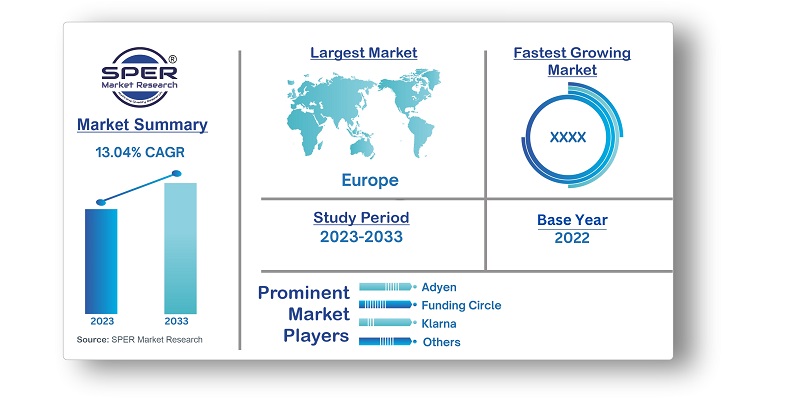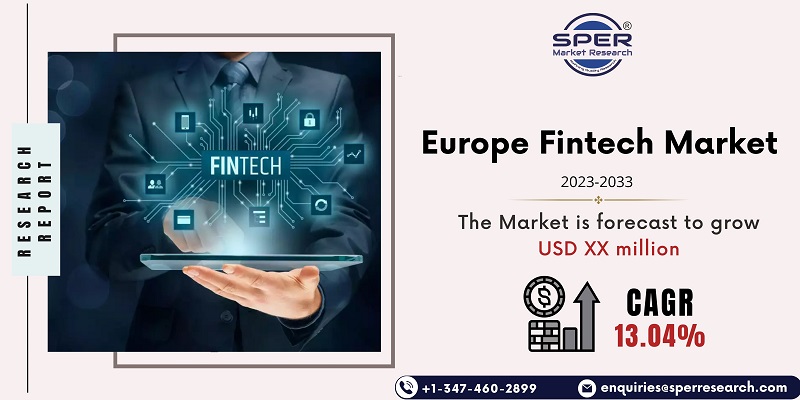
Europe Fintech Market Growth, Size, Trends, Share, Revenue, Demand and Future Outlook
Europe Fintech Market Size- By Deployment Mode, By Technology, By Application, By End User- Regional Outlook, Competitive Strategies and Segment Forecast to 2033
| Published: Dec-2023 | Report ID: BFSI2353 | Pages: 1 - 153 | Formats*: |
| Category : BFSI | |||
- In March 2022, Adyen, a leading global financial technology platform, announced plans to go beyond payments and develop integrated financial products. With the help of these products, marketplaces and platforms will be able to provide users—like small business owners or individual sellers—with customized financial experiences.
- June 2021: Two significant German fintech startups and competitors, Raisin and Deposit Solutions, intended to merge to create a pan-European organization that would provide cutting-edge, API-based B2B and B2C products in the savings and portfolio management domains.


| Report Metric | Details |
| Market size available for years | 2019-2033 |
| Base year considered | 2022 |
| Forecast period | 2023-2033 |
| Segments covered | By Deployment Mode, By Technology, By Application, By End User |
| Regions covered | Eastern Region, Western Region, Southern Region, Northern Region |
| Companies Covered | Adyen, Funding Circle, Klarna, Monzo, N26, Nexi, Oaknorth, Rapyd, Revolut, Transferwise, Others |
- Financial Institutions
- Startups and Entrepreneurs
- Investors and Venture Capital Firms
- Regulatory Authorities
- Technology and Solution Providers
- Customers
| By Deployment Mode: |
|
| By Technology: |
|
| By Application: |
|
| By End User: |
|
- Europe Fintech Market Size (FY’2023-FY’2033)
- Overview of Europe Fintech Market
- Segmentation of Europe Fintech Market By Deployment Mode (On-premises, Cloud-based)
- Segmentation of Europe Fintech Market By Technology (Application Programming Interface, Artificial Intelligence, Blockchain, Data Analytics, Robotic Process Automation, Others)
- Segmentation of Europe Fintech Market By Application (Insurance and Personal Finance, Loans, Payment and Fund Transfer, Wealth Management, Others)
- Segmentation of Europe Fintech Market By End User (Banking, Insurance, Securities, Others)
- Expansion Analysis of Europe Fintech Market
- Problems and Obstacles in Europe Fintech Market
- Competitive Landscape in the Europe Fintech Market
- Impact of COVID-19 and Demonetization on Europe Fintech Market
- Details on Current Investment in Europe Fintech Market
- Competitive Analysis of Europe Fintech Market
- Prominent Players in the Europe Fintech Market
- SWOT Analysis of Europe Fintech Market
- Europe Fintech Market Future Outlook and Projections (FY’2023-FY’2033)
- Recommendations from Analyst
1.1. Scope of the report1.2. Market segment analysis
2.1. Research data source2.1.1. Secondary Data2.1.2. Primary Data2.1.3. SPER’s internal database2.1.4. Premium insight from KOL’s2.2. Market size estimation2.2.1. Top-down and Bottom-up approach2.3. Data triangulation
4.1. Driver, Restraint, Opportunity and Challenges analysis4.1.1. Drivers4.1.2. Restraints4.1.3. Opportunities4.1.4. Challenges4.2. COVID-19 Impacts of the Europe Fintech Market
5.1. SWOT Analysis5.1.1. Strengths5.1.2. Weaknesses5.1.3. Opportunities5.1.4. Threats5.2. PESTEL Analysis5.2.1. Political Landscape5.2.2. Economic Landscape5.2.3. Social Landscape5.2.4. Technological Landscape5.2.5. Environmental Landscape5.2.6. Legal Landscape5.3. PORTER’s Five Forces5.3.1. Bargaining power of suppliers5.3.2. Bargaining power of buyers5.3.3. Threat of Substitute5.3.4. Threat of new entrant5.3.5. Competitive rivalry5.4. Heat Map Analysis
6.1. Europe Fintech Market Manufacturing Base Distribution, Sales Area, Product Type6.2. Mergers & Acquisitions, Partnerships, Product Launch, and Collaboration in Europe Fintech Market
7.1. Europe Fintech Market Value Share and Forecast, By Deployment Mode, 2023-20337.2. On-premises7.3. Cloud-based
8.1. Europe Fintech Market Value Share and Forecast, By Technology, 2023-20338.2. Application Programming Interface8.3. Artificial Intelligence8.4. Blockchain8.5. Data Analytics8.6. Robotic Process Automation8.7. Others
9.1. Europe Fintech Market Value Share and Forecast, By Application, 2023-20339.2. Insurance and Personal Finance9.3. Loans9.4. Payment and Fund Transfer9.5. Wealth Management9.6. Others
10.1. Europe Fintech Market Value Share and Forecast, By End User, 2023-203310.2. Banking10.3. Insurance10.4. Securities10.5. Others
11.1. Europe Fintech Market Size and Market Share
12.1. Europe Fintech Market Size and Market Share By Deployment Mode (2019-2026)12.2. Europe Fintech Market Size and Market Share By Deployment Mode (2027-2033)
13.1. Europe Fintech Market Size and Market Share By Technology (2019-2026)13.2. Europe Fintech Market Size and Market Share By Technology (2027-2033)
14.1. Europe Fintech Market Size and Market Share By Application (2019-2026)14.2. Europe Fintech Market Size and Market Share By Application (2027-2033)
15.1. Europe Fintech Market Size and Market Share By End User (2019-2026)15.2. Europe Fintech Market Size and Market Share By End User (2027-2033)
16.1. Europe Fintech Market Size and Market Share By Region (2019-2026)16.2. Europe Fintech Market Size and Market Share By Region (2027-2033)16.3. Eastern Region16.4. Western Region16.5. Southern Region16.6. Northern Region
17.1. Adyen17.1.1. Company details17.1.2. Financial outlook17.1.3. Product summary17.1.4. Recent developments17.2. Funding Circle17.2.1. Company details17.2.2. Financial outlook17.2.3. Product summary17.2.4. Recent developments17.3. Klarna17.3.1. Company details17.3.2. Financial outlook17.3.3. Product summary17.3.4. Recent developments17.4. Monzo17.4.1. Company details17.4.2. Financial outlook17.4.3. Product summary17.4.4. Recent developments17.5. N2617.5.1. Company details17.5.2. Financial outlook17.5.3. Product summary17.5.4. Recent developments17.6. Nexi17.6.1. Company details17.6.2. Financial outlook17.6.3. Product summary17.6.4. Recent developments17.7. Oaknorth17.7.1. Company details17.7.2. Financial outlook17.7.3. Product summary17.7.4. Recent developments17.8. Rapyd17.8.1. Company details17.8.2. Financial outlook17.8.3. Product summary17.8.4. Recent developments17.9. Revolut17.9.1. Company details17.9.2. Financial outlook17.9.3. Product summary17.9.4. Recent developments17.10. Transferwise17.10.1. Company details17.10.2. Financial outlook17.10.3. Product summary17.10.4. Recent developments17.11. Others
SPER Market Research’s methodology uses great emphasis on primary research to ensure that the market intelligence insights are up to date, reliable and accurate. Primary interviews are done with players involved in each phase of a supply chain to analyze the market forecasting. The secondary research method is used to help you fully understand how the future markets and the spending patterns look likes.
The report is based on in-depth qualitative and quantitative analysis of the Product Market. The quantitative analysis involves the application of various projection and sampling techniques. The qualitative analysis involves primary interviews, surveys, and vendor briefings. The data gathered as a result of these processes are validated through experts opinion. Our research methodology entails an ideal mixture of primary and secondary initiatives.



Frequently Asked Questions About This Report
PLACE AN ORDER
Year End Discount
Sample Report
Pre-Purchase Inquiry
NEED CUSTOMIZATION?
Request CustomizationCALL OR EMAIL US
100% Secure Payment






Related Reports
Our Global Clients
Our data-driven insights have influenced the strategy of 200+ reputed companies across the globe.




















